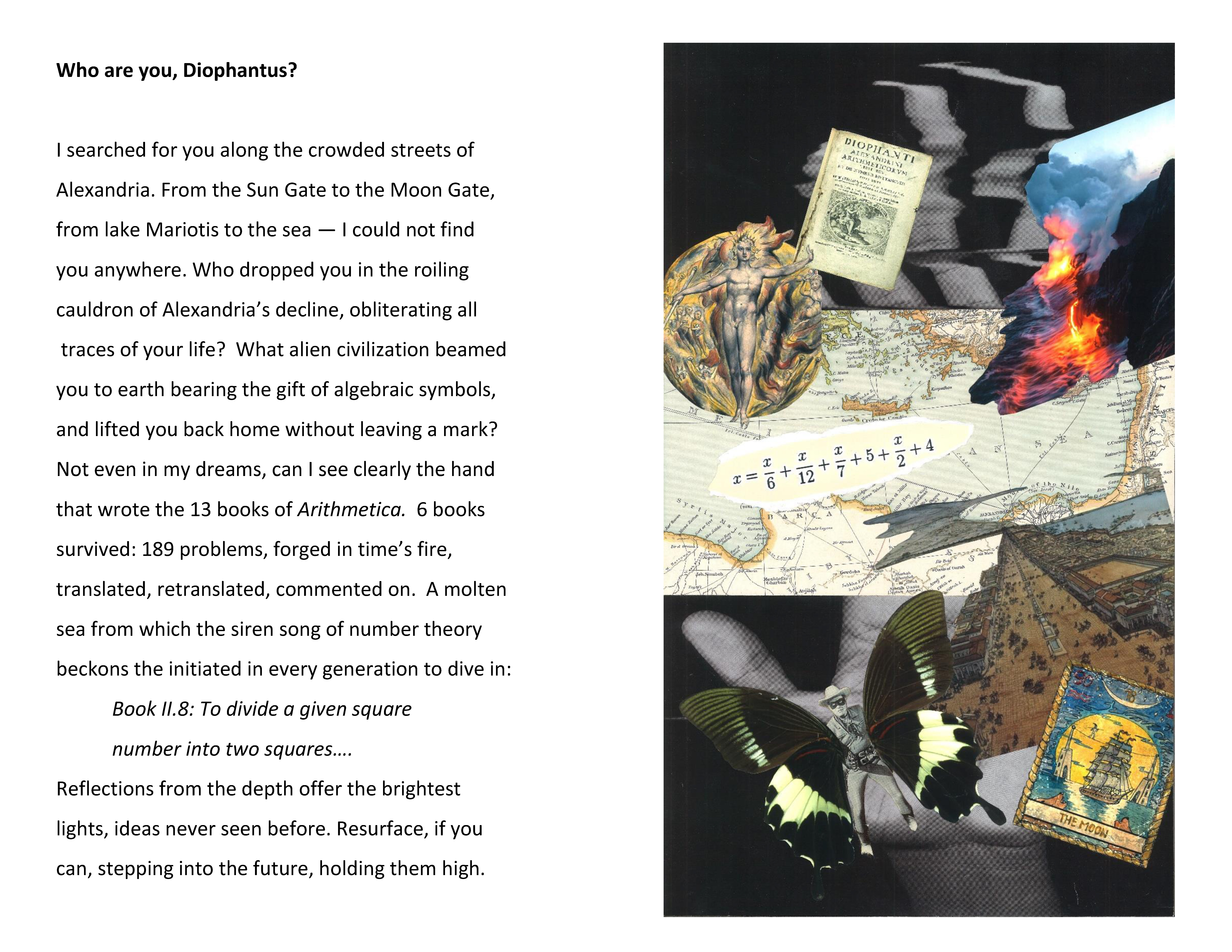A Poem-Collage Project
Poem by Sarah Glaz with Collage by Mark Sanders
The poem-collage pair appears in the Bridges 2025 online art gallery: Sarah Glaz, Mark Sanders | Bridges 2025 Exhibition of Mathematical Art, Craft, and Design | Mathematical Art Galleries
 |
 |
History, Mathematics, Poem, Collage
Diophantus
(ca.
200 - 284 CE) was a Greek mathematician who lived in
Alexandria, Egypt. Considered the "Father of Algebra," he
authored a work of great genius, Arithmetica.
Innovative in both subject matter and approach to problems, Arithmetica
paved the way to the development of symbolic algebra, and to
the advancement of the area of mathematics called number
theory.
Diophantus
lived
during a dark and turbulent time in the history of Alexandria.
The city with its legendary institutes of learning, the Museum
and its magnificent library, began its decline several hundred
years before. The Golden Age of Greek Mathematics initiated by
Euclid ended in the 2nd century BCE when anarchic
conditions brought on by political strife and frequent ethnic
and religious clashes contributed to the decline of original
scholarship at the Museum. A further blow was delivered by the
Roman conquest of the city and the establishment of a military
regime in 30 BCE. Shortly before Diophantus' birth, during the
Kitos Wars, a large part of the city was destroyed. The
situation deteriorated further during Diophantus' lifetime. In
215, Emperor Caracalla visited the city and, insulted by a
satire directed at him by the city's inhabitants, ordered the
slaying of all the city's youth capable of bearing arm.
Alexandria features prominently in both poem and collage. The
main thoroughfare of Alexandria, the Canopic Way, mentioned
indirectly in the first few lines of the poem, is depicted in
the collage below and to the right of the central map segment.
Canopic Way stretched from the Sun Gate in the east
(represented by William Blake's figure, from "The Sun at His
Eastern Gate," holding high a copy of Diophantus' Arithmetica),
to the Moon Gate in the west (represented by the Moon Tarot
card, signifying the light of the imagination, which guides
the spirit through times of darkness).
Almost
nothing
is known about Diophantus as an individual. The meager
information we possess, comes from a riddle in verse,
circulating since the 4th century CE, which, when translated
into modern algebraic notation gives rise to the equation
appearing in the center of the collage. Solving this equation,
we obtain that Diophantus' age at his death was x =
84. The mystery surrounding Diophantus' person expressed in
the poem and its title, is reflected in the collage by casting
Diophantus as the masked figure descending to earth on the
wings of the Sumatran Swallowtail butterfly, Papilio
Diophantus.
Greek
mathematics'
main focus had been on geometry. Even when solving algebraic
equations, the methods employed were geometrical. In contrast,
Diophantus' Arithmetica was a treatise in algebra and
number theory. Six out of its thirteen books survived either
in the original Greek or in Arabic translations. The treatise,
comprising of 189 problems with their solutions, solved
algebraic equations by abstract algebraic means. Moreover, it
introduced various algebraic symbols rather than describing
the equations with words alone, as done by its predecessors.
One of the main contributions of this approach was the
beginning of symbolic algebra, which will not proceed to the
next step in its development till late 15th
century. In addition, the problems and their ingenious
solutions provided, through the ages, a constant source of
inspiration for generalizations that became a driving force
behind the development of number theory.
The
most spectacular example of this kind, the so called "Fermat's
Last Theorem," is a conjecture posed by the 17th
century French mathematician, Pierre de Fermat, in response to
Problem 8 from Arithmetica, Book II (cited in the
poem), stating that:
No
integer solutions x, y, and z, exist to the equation xn
+ yn = zn, if n is larger than
2.
The
conjecture was solved in the affirmative in 1997 by British
mathematician, Andrew Wiles. In the over 300 years that passed
since Fermat's conjecture and Wiles' proof, there had been
numerous attempts to prove the conjecture, some with partial
success. More important, many mathematical tools and deep
theories were developed as a result of these attempts. This is
where the true contribution of Diophantus' problems lie.
Without them a large chunk of modern mathematics would simply
not exist.
For more details see Mark's Dissecting
Diophantus.
